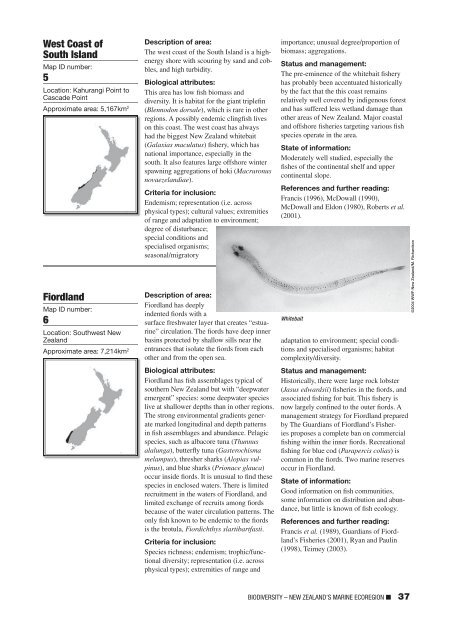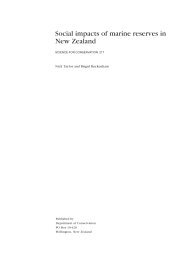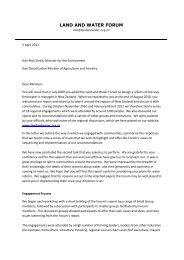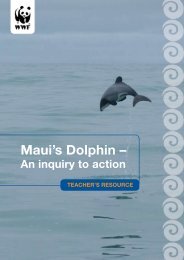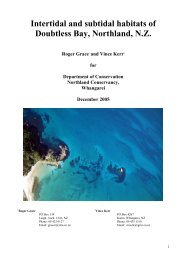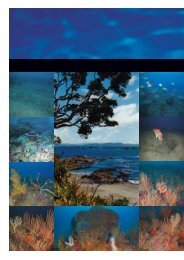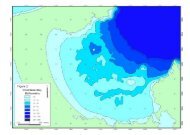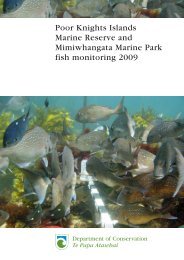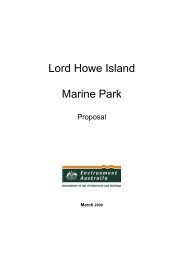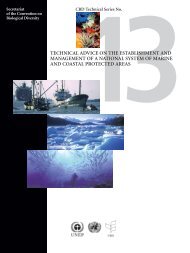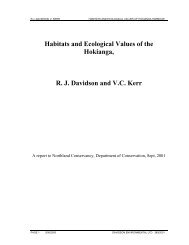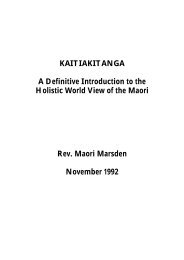WWF Shining a spotlight on the biodiversity of ... - MarineNZ.org.nz
WWF Shining a spotlight on the biodiversity of ... - MarineNZ.org.nz
WWF Shining a spotlight on the biodiversity of ... - MarineNZ.org.nz
Create successful ePaper yourself
Turn your PDF publications into a flip-book with our unique Google optimized e-Paper software.
West Coast <strong>of</strong><br />
South Island<br />
Map ID number:<br />
5<br />
Locati<strong>on</strong>: Kahurangi Point to<br />
Cascade Point<br />
Approximate area: 5,167km 2<br />
Fiordland<br />
Map ID number:<br />
6<br />
Locati<strong>on</strong>: Southwest New<br />
Zealand<br />
Approximate area: 7,214km 2<br />
Descripti<strong>on</strong> <strong>of</strong> area:<br />
The west coast <strong>of</strong> <strong>the</strong> South Island is a highenergy<br />
shore with scouring by sand and cobbles,<br />
and high turbidity.<br />
Biological attributes:<br />
This area has low fish biomass and<br />
diversity. It is habitat for <strong>the</strong> giant triplefin<br />
(Blennod<strong>on</strong> dorsale), which is rare in o<strong>the</strong>r<br />
regi<strong>on</strong>s. A possibly endemic clingfish lives<br />
<strong>on</strong> this coast. The west coast has always<br />
had <strong>the</strong> biggest New Zealand whitebait<br />
(Galaxias maculatus) fishery, which has<br />
nati<strong>on</strong>al importance, especially in <strong>the</strong><br />
south. It also features large <strong>of</strong>fshore winter<br />
spawning aggregati<strong>on</strong>s <strong>of</strong> hoki (Macrur<strong>on</strong>us<br />
novaezelandiae).<br />
Criteria for inclusi<strong>on</strong>:<br />
Endemism; representati<strong>on</strong> (i.e. across<br />
physical types); cultural values; extremities<br />
<strong>of</strong> range and adaptati<strong>on</strong> to envir<strong>on</strong>ment;<br />
degree <strong>of</strong> disturbance;<br />
special c<strong>on</strong>diti<strong>on</strong>s and<br />
specialised <strong>org</strong>anisms;<br />
seas<strong>on</strong>al/migratory<br />
Descripti<strong>on</strong> <strong>of</strong> area:<br />
Fiordland has deeply<br />
indented fiords with a<br />
surface freshwater layer that creates “estuarine”<br />
circulati<strong>on</strong>. The fiords have deep inner<br />
basins protected by shallow sills near <strong>the</strong><br />
entrances that isolate <strong>the</strong> fiords from each<br />
o<strong>the</strong>r and from <strong>the</strong> open sea.<br />
Biological attributes:<br />
Fiordland has fish assemblages typical <strong>of</strong><br />
sou<strong>the</strong>rn New Zealand but with “deepwater<br />
emergent” species: some deepwater species<br />
live at shallower depths than in o<strong>the</strong>r regi<strong>on</strong>s.<br />
The str<strong>on</strong>g envir<strong>on</strong>mental gradients generate<br />
marked l<strong>on</strong>gitudinal and depth patterns<br />
in fish assemblages and abundance. Pelagic<br />
species, such as albacore tuna (Thunnus<br />
alalunga), butterfly tuna (Gasterochisma<br />
melampus), thresher sharks (Alopias vulpinus),<br />
and blue sharks (Pri<strong>on</strong>ace glauca)<br />
occur inside fiords. It is unusual to find <strong>the</strong>se<br />
species in enclosed waters. There is limited<br />
recruitment in <strong>the</strong> waters <strong>of</strong> Fiordland, and<br />
limited exchange <strong>of</strong> recruits am<strong>on</strong>g fiords<br />
because <strong>of</strong> <strong>the</strong> water circulati<strong>on</strong> patterns. The<br />
<strong>on</strong>ly fish known to be endemic to <strong>the</strong> fiords<br />
is <strong>the</strong> brotula, Fiordichthys slartibartfasti.<br />
Criteria for inclusi<strong>on</strong>:<br />
Species richness; endemism; trophic/functi<strong>on</strong>al<br />
diversity; representati<strong>on</strong> (i.e. across<br />
physical types); extremities <strong>of</strong> range and<br />
importance; unusual degree/proporti<strong>on</strong> <strong>of</strong><br />
biomass; aggregati<strong>on</strong>s.<br />
Status and management:<br />
The pre-eminence <strong>of</strong> <strong>the</strong> whitebait fishery<br />
has probably been accentuated historically<br />
by <strong>the</strong> fact that <strong>the</strong> this coast remains<br />
relatively well covered by indigenous forest<br />
and has suffered less wetland damage than<br />
o<strong>the</strong>r areas <strong>of</strong> New Zealand. Major coastal<br />
and <strong>of</strong>fshore fisheries targeting various fish<br />
species operate in <strong>the</strong> area.<br />
State <strong>of</strong> informati<strong>on</strong>:<br />
Moderately well studied, especially <strong>the</strong><br />
fishes <strong>of</strong> <strong>the</strong> c<strong>on</strong>tinental shelf and upper<br />
c<strong>on</strong>tinental slope.<br />
References and fur<strong>the</strong>r reading:<br />
Francis (1996), McDowall (1990),<br />
McDowall and Eld<strong>on</strong> (1980), Roberts et al.<br />
(2001).<br />
Whitebait<br />
adaptati<strong>on</strong> to envir<strong>on</strong>ment; special c<strong>on</strong>diti<strong>on</strong>s<br />
and specialised <strong>org</strong>anisms; habitat<br />
complexity/diversity.<br />
Status and management:<br />
Historically, <strong>the</strong>re were large rock lobster<br />
(Jasus edwardsii) fisheries in <strong>the</strong> fiords, and<br />
associated fishing for bait. This fishery is<br />
now largely c<strong>on</strong>fined to <strong>the</strong> outer fiords. A<br />
management strategy for Fiordland prepared<br />
by The Guardians <strong>of</strong> Fiordland’s Fisheries<br />
proposes a complete ban <strong>on</strong> commercial<br />
fishing within <strong>the</strong> inner fiords. Recreati<strong>on</strong>al<br />
fishing for blue cod (Parapercis colias) is<br />
comm<strong>on</strong> in <strong>the</strong> fiords. Two marine reserves<br />
occur in Fiordland.<br />
State <strong>of</strong> informati<strong>on</strong>:<br />
Good informati<strong>on</strong> <strong>on</strong> fish communities,<br />
some informati<strong>on</strong> <strong>on</strong> distributi<strong>on</strong> and abundance,<br />
but little is known <strong>of</strong> fish ecology.<br />
References and fur<strong>the</strong>r reading:<br />
Francis et al. (1989), Guardians <strong>of</strong> Fiordland’s<br />
Fisheries (2001), Ryan and Paulin<br />
(1998), Teirney (2003).<br />
©2004 <str<strong>on</strong>g>WWF</str<strong>on</strong>g>-New Zealand/M. Richards<strong>on</strong><br />
BIODIVERSITY – NEW ZEALAND’S MARINE ECOREGION ■ 37


